EviBAN toolbox for adaptive water management
The toolbox is a compilation of assessment tools for adaptive water management and application of these in the cases studies of EviBAN in Norway, Finland, South Africa, and France. The aim is to support planning and decision making required for implementation of Natural Water Retention Measures (NWRM) and similar Nature Based Solutions (NBS).
The toolbox is a compilation of assessment tools for adaptive water management and application of these in the cases studies of EviBAN in Norway, Finland, South Africa, and France.
The aim is to support planning and decision making required for implementation of Natural Water Retention Measures (NWRM) and similar Nature Based Solutions (NBS).
The methods and tools provide qualitative and quantitative results, which include technical performance, environmental, economic, governance and social aspects of the solutions. The tools are related to assessments at different stages of the planning and decision-making process as illustrated in Figure 1.
Tools developed in EviBAN
- Governance assessment (GA) in EviBAN
- Optimization of NBS in EviBAN
- Integrated Sustainability Assessment (ISA) in EviBAN
Studies in EviBAN using more detailed existing (open access) assessment tools, incl. references to tools
- Stormwater management under changing climate with dynamic model of NWRM
- Managed Aquifer Recharge (MAR) and Soil Aquifer Treatment (SAT) under changing climate
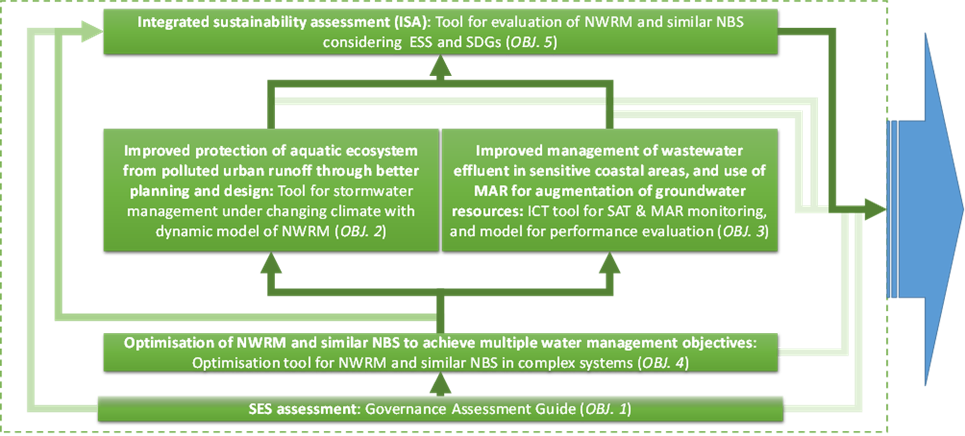
Governance assessment (GA) in EviBAN
The GA tool provides a systematic assessment of the conditions, drivers, and barriers to NBS for water management in different governance contexts. The tool is qualitative, consisting of a text-based manual and an Excel-file to structure data collection and assessment according to a set of dimensions and topic areas identified in previous research, before highlighting key factors of influence in a summary scorecard (Figure 2).
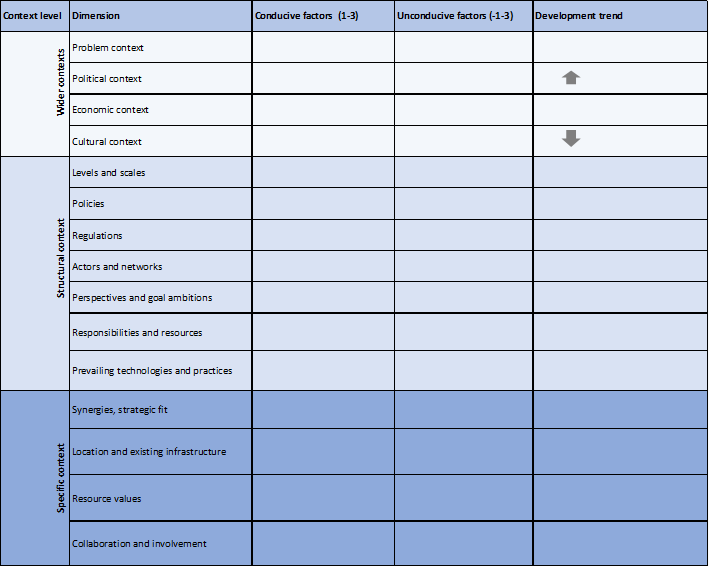
The GA builds on previous assessment frameworks developed in the EU projects DROP and DESSIN. Governance is seen as a multi-level process where many factors are of influence in so far as they affect the motivations, cognitions and/or resources of the actors. These factors form a multi-layered context with three levels.
- Specific context, including factors like the geographical place of the project or initiative in focus, and its case history, consisting of previous decision-making and framing.
- Structural context, which includes the established governance regime and the relevant property and use rights and encompassing the specific context.
- Wider contexts, a layer consisting of exogenous societal developments and trends.
The concept in EviBAN applies the same set of distinctions but pays special attention to interactions across sectors. Furthermore, it draws on socio-ecological system (SES) perspectives, where different governance functions are associated with different Action Situations, including resource flows and operational factors. Lastly, perspectives from the literature on sustainability transitions, with its notions of path dependence, lock-ins, and windows of opportunities, have inspired the questions and evaluative criteria. The overall conceptual framework of the governance assessment tool in EviBAN is visualised in Figure 3.

DOWNLOAD the GA tool
- Link to the text manual of the GA tool: GA Tool - text manual
- Link to the spreadsheet template: GA Tool - Excel template
GA studies in EviBAN
- Damman, S., et al., Drivers and barriers to NWRM/NBS based on the application of the governance assessment tool (paper in preparation)
Optimization of NBS in EviBAN
Optimization in EviBAN aims at findings optimal NBS measures, based on performance and cost criteria, for the case study under consideration. The optimization tool in EviBAN consists of a mathematical model of the case study, an optimization algorithm, and a software implementation that couple the model with the optimization algorithm.
In EviBAN, three optimization tools were developed:
-
NBSopt:
This tool is developed to optimize NBS for stormwater management. With this tool, the user can create a simple model of a catchment with a set of connected nodes (Figure 4). The input to the tool is an Excel-file where the user can create the node model of the catchment and provide inputs to the optimization algorithm. The tool is created as a python code and can be used to find the optimal NBS measures based either on a given cost or a given discharge limit (single objective optimization). Figure 5 shows an example for the results of NBSopt:
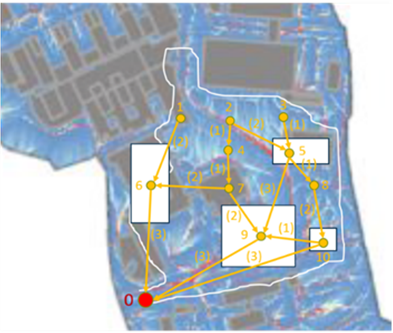

NBSopt is fast and easy to use. Hence, it is recommended as a screening tool, e.g., early on in decision processes before the suggested NBS solutions will be analysed and designed in more detail in other dedicated tools such as SWMM or MAR/SAT.
DOWNLOAD NBSopt:
- The python code: NBSopt code
- The excel-file template: NBSopt input
- NBS-opt text manual from EviBAN Deliverable 2.1[[1]], Chapter 3: NBSopt - text manual
- A case study using NBSopt providing a guide for parameterization: NBSopt case study
-
SWMMLIDopt
SWMMLIDopt uses the Storm Water Management Model (SWMM) and provides a user-friendly environment for conducting multi-objective optimization of the selection and placement of NBS measures for stormwater management.
The SWMMLIDopt operates from a simplified user interface that prepares the optimization input, executes the multi-objective optimization, based on the total cost and reduction of peak drainage flow rates, and visualizes the optimization results (Figure 6).
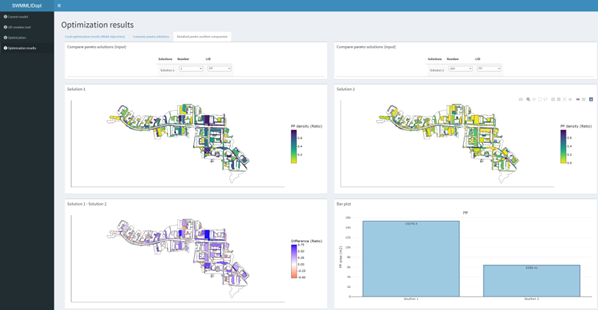
DOWNLOAD SWMMLIDopt:
To download SWMMLIDopt, follow the steps in this link: SWMMLIDopt. This link also provides a step-by-step guide on how to use the SWMMLIDopt tool.
-
MARopt
MARopt tool is created for optimizing the placement of Managed Aquifer Recharge (MAR) measures at rural catchments, based on coupling a node-based hydrological model with a multi-objective optimization algorithm (Figure 7). MARopt allows the user to create a simple node model that can be calibrated and compared with measurement. Then, the calibrated hydrological model can be used to generate pareto optimal solutions for NBS based on cost and performance, which can be visualised and compared in the tool.
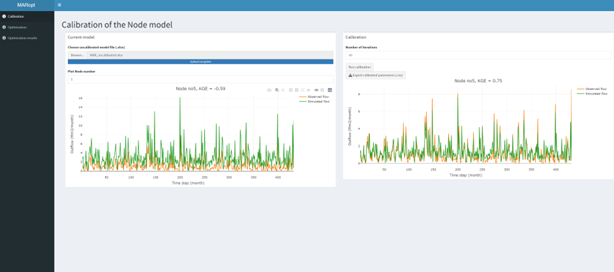
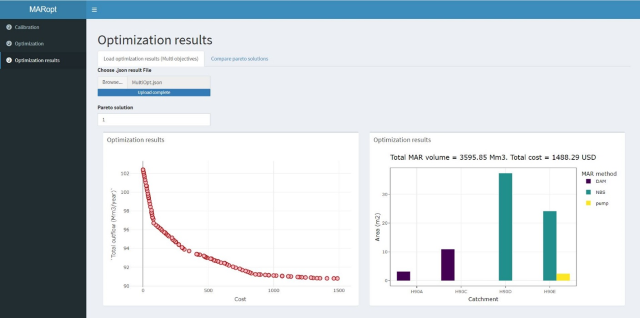
DOWNLOAD MARopt:
The MARopt tool is available online in this link: https://eviban.shinyapps.io/maropt/ . MARopt is available in a GitHUB page, where a step-by-step example on how to use the tool is provided
Optimisation case studies in EviBAN
- Da Silva (2021) set up SWMM and EviBAN pre-screening NWRM model to an urban block and demonstrated how SWMM results can be used as a reference in parameterising the EviBAN pre-screening tool to simulate impacts on NWRM on design storm flow event. (https://aaltodoc.aalto.fi/handle/123456789/112621)
- Elhadi et al. (2023) SWMMLIDopt: a tool for optimization of low impact development (LID) measures using the SWMM model (paper submitted for publication)
- Helness et al. Optimising measures for runoff management to augment water resources using a multi objective optimisation tool – MARopt (paper in preparation)
Stormwater management under changing climate with dynamic model of NWRM
The stormwater modelling in EviBAN was based on the two open-source modelling platforms: Stormwater Management Model (SWMM) by USEPA (Figure 8) and PHREEQ-C by USGS for simulating chemical reactions and transport processes.
SWMM in EviBAN
Stormwater modelling and SWMM in EviBAN toolbox are documented in
- EviBAN Deliverable 2.1[1], Chapter 4: Stormwater management tool. The document summarises SWMM and PHREEQC for EviBAN case studies
SWMM case studies in EviBAN
- Khadka et al. (2021) (https://doi.org/10.1016/j.jhydrol.2021.126768) used SWMM to assess LID impacts on urban storage volume when aiming to restore part of the hydrological regime corresponding to pre-development conditions.
- Tamm et al. (2023) (https://doi.org/10.1016/j.jhydrol.2023.129656) applied SWMM to simulate how urban hydrological variables respond to changes in future climatic conditions using downscaled high temporal resolution scenarios of air temperature and precipitation from regional climate models.
- Di Natale (2022) (https://webthesis.biblio.polito.it/24177/) and Di Natale et al. (2023) (link not available) constructed low impact development solutions (i.e. NWRM) and simulated across northern seasons their impact on hydrological regime under changing climate.
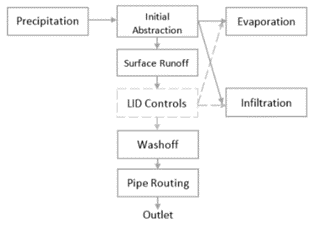
PHREEQC and stormwater case studies in EviBAN
- Dubovik et al. (2023) (link not available) set up PHREEQC in connection with hydrological models to simulate geochemical behaviour of road runoff filters and assess their long-term treatment capacity.
OPEN-SOURCE MODELS
DOWNLOAD SWMM
The latest SWMM model can be downloaded from the webpage of the US Environmental Protection Agency. The download page also contains guides for simulation of hydrological and hydraulic processes in an urban catchment (see e.g., Figure 9) as well as the low impact development modules, which are under the water quality guide.
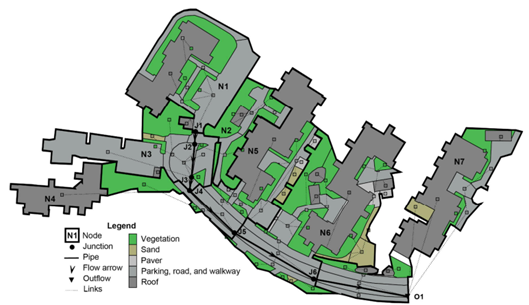
DOWNLOAD PHREEQC
- The latest PHREEQC model can be downloaded from the webpages of US Geological Survey.
Managed Aquifer Recharge (MAR) and Soil Aquifer Treatment (SAT) under changing climate
The managed aquifer recharge (MAR) and Soil Aquifer Treatment (SAT) modelling tools in EVIBAN were based on different modelling tools, software packages and platforms. These have different requirements for use, some are open source, some require registration, and some require purchase of a license depending on the version. Information is provided in the references to the tools.
The applications in EviBAN of these on the case studies in France and South Africa are provided below, followed by references to the modelling tools.
Applications in EviBAN of models, software, and platforms
MARTHE by BRGM was applied for simulating 3D flow and solute transport in a hydrosystem, and PHREEQ-C by USGS was applied for simulating chemical reactions. CXTFIT (Tang et al. 2010)[2] was used for data analysis. EMI-SMD by SAUR (ImaGeau) was used for monitoring of the subsurface conditions. NORMANN by AnteaGroup was used in the development of a MAR-module in the software for determination of areas favourable for the implementation of an MAR/SAT system.
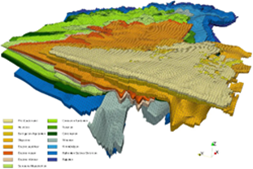
Applications in EviBAN
The tools for SAT and MAR monitoring and performance evaluation were applied in the French study case of Agon-Coutainville:
Introduction and previous projects
- EviBAN Deliverable 2.1[1], Chapter 5: Tool for SAT & MAR monitoring, and model for performance evaluation
EMI-SMD in EviBAN
- EviBAN Deliverable 2.1[1], Chapter 5.1: System Monitoring Device (SMD) and the Environmental Monitoring Interface (EMI)
NORRMAN in EviBAN
- EviBAN Deliverable 2.1[1], Chapter 5.2: NORRMAN-MAR
MARTHE in EviBAN
- EviBAN Deliverable 2.1[1], Chapter 5.4: HYDROGEOLOGICAl MODEL: MARTHE CODE
MAR/SAT studies in EviBAN:
- PhD works of Quentin Guillemoto and is documented in Quentin Guillemoto (2022) in the thesis manuscript, BRGM-METIS - Sorbonne University (http://theses.hal.science/tel-04061989) focuses on Transfer of trace organic molecules from treated wastewater in a Soil Aquifer Treatment (SAT) system: application to the coastal hydrosystem of Agon-Coutainville;
- Guillemoto et al. (2023) in Water 2023, 15, 934 publication: Guillemoto, Q.; Picot-Colbeaux, G.; Valdes, D.; Devau, N.; Thierion, C.; Idier, D.; Mathurin, F.A.; Pettenati, M.; Mouchel, J.-M.; Kloppmann, W. Multi-Annual Dynamics of a Coastal Groundwater System with Soil-Aquifer Treatment and Its Impact on the Fate of Trace Organic Compounds. https://doi.org/10.3390/w15050934
- Guillemoto et al. (2022) in Sci. Total Environ. 836, 155643 publication: Guillemoto, Q., Picot-Colbeaux, G., Valdes, D., Devau, N., Mathurin, F.A., Pettenati, M., Kloppmann, W., Mouchel, J.-M., 2022. Transfer of trace organic compounds in an operational soil-aquifer treatment system assessed through an intrinsic tracer test and transport modelling. https://doi.org/10.1016/j.scitotenv.2022.155643 The study includes use of CXTFIT
- Technical report about MAR solutions in South Africa and France : 2 EviBAN report_MAR tool [[3]]
MODELSs, SOFTWARE, AND PLATFORMS
DOWNLOAD MARTHE (BRGM)
- https://www.brgm.fr/en/software/marthe-modelling-software-groundwater-flows The latest MARTHE modelling Software for groundwater flows and solute transport can be downloaded from the webpages of BRGM – The French geological survey, for the free limited version and can be asking for License of the full version.
The download page also contains guides, tutorials, examples for simulation of hydrological and hydraulic processes (Thiéry, 2021[4]; Thiéry, 2006[5]; Thiéry and Picot-Colbeaux, 2020[6]) as well as linked with other modelling tools or modules as GARDENIA (https://www.brgm.fr/en/software/gardenia-lumped-hydrological-modelling-catchment-basin), PHREEQC and training possibilities.
DOWNLOAD PHREEQC linked “thermoddem” database (BRGM)
https://www.usgs.gov/software/phreeqc-version-3. The latest PHREEQC model can be downloaded from the web-pages of US Geological Survey and linked database “thermoddem” from the web-pages of BRGM – The French geological survey https://thermoddem.brgm.fr/databases/phreeqc.
DOWNLOAD NORRMAN (ANTEAGROUP)
- http://www.lyxea.fr/geo-hyd/nos-references NORRMAN can be implemented ANTEAGROUP, first built for Self-Purification Assessment of the Loire Bretagne basin in France (https://www.ille-et-vilaine.gouv.fr/content/download/35160/255420/file/010-B-resume.pdf, https://sdage-sage.eau-loire-bretagne.fr/files/live/mounts/midas/Donnees-et-documents/PUBLI_EDL2019-HD.pdf)
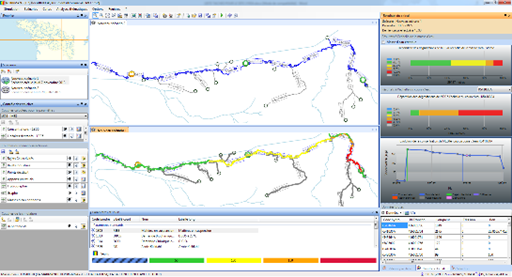
DOWNLOAD CXTFIT
- https://cxtfit.github.io/ the Analytical equations and the nonlinear parametric estimation are available on the package CXTFIT[7] in Excel to provide flexibility in analysing multiple tracers experiment data and added sensitivity and uncertainty analysis functions to facilitate multi-model analysis.
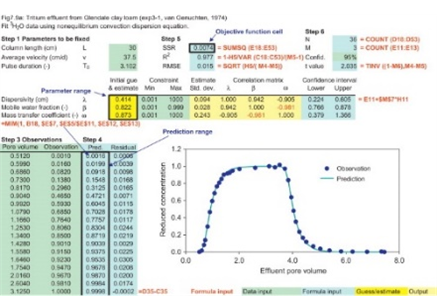
CONNEXION to EMI-SMD (IMAGEAU)
- https://emi.imageau.eu/ EMI-SMD the System Monitoring Device and the Environmental Monitoring Interface can be provided by IMAGEAU (SAUR) by implement sensors on study site connected and readable on web-applet with dedicated logging.
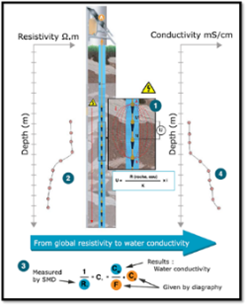
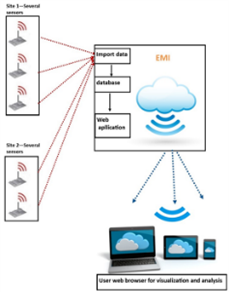
OTHER EXISTING TOOLS
Complementary approaches already exist through applets deliver by the FRAME Decision Support System (DSS) http://www.frame-project.eu/previous-news/dss/index.html , http://www.geo-hyd.net/install/Frame_DSS/), the INOWAS Platform (T13. Travel Time Through Unconfined Aquifer: https://inowas.com/tools/t13-travel-time-through-unconfined-aquifer/ and T08. One-Dimensional Transport Equation: https://inowas.com/tools/t08-one-dimensional-transport-equation/ and T19. Groundwater residence time: https://inowas.com/tools/t19-groundwater-residence-time/) and the AQUANES DSS (http://dss.aquanes.eu/Default.aspx?t=1756)
Integrated Sustainability Assessment (ISA) in EviBAN
The Integrated Sustainability Assessment (ISA) tool is an indicator-based assessment framework covering five dimensions of sustainability.
- Technical performance (Tp)
- Social (S)
- Environmental (En)
- Economic (Ec)
- Governance (G)
The ISA tool is intended to be used to assess alternative solutions for stormwater management or managed aquifer recharge. The perspective of the framework is that of an end user or decision maker wanting to assess NWRM or similar NBS and compare with other water management alternatives.
The ISA framework has seventy-seven indicators to describe properties of the solutions in the five sustainability dimensions. These have been developed and selected based on discussions with the stakeholders in the case studies of EviBAN who provided inputs through on-line questionnaires and in workshops, and on review of previous studies in the open scientific literature as illustrated in Figure 10.
The seventy-seven indicators provide a point of departure for selection of indicators that are relevant for the specific assessment.
The selection, weighting and quantification of the selected indicators should involve local stakeholders.
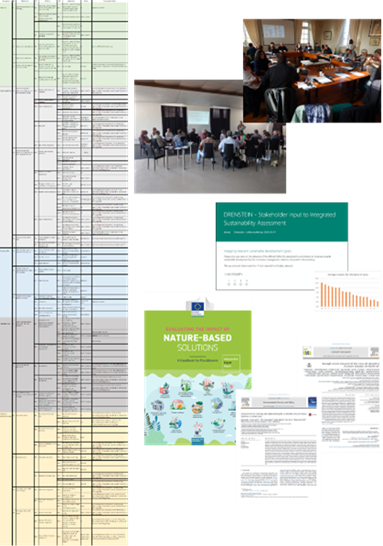
The tool consists of an explanatory text manual and an Excel-file with the indicators and a template for filling data. The structure of the framework is like what has been used in other studies[8],[9],[10].
Results of the assessment can be resented as bar charts or in radar plots (Figure 11), or after a multi-criteria analysis as presented in a previous study[11].
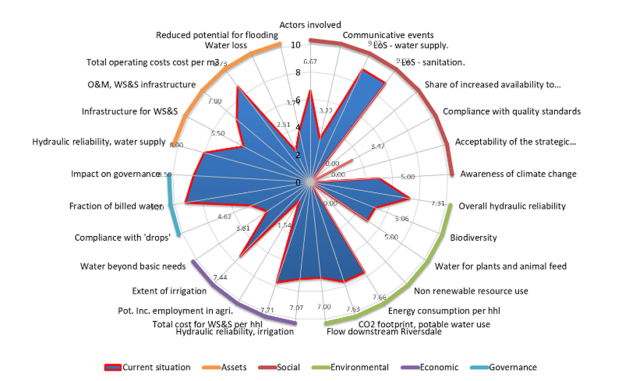
DOWNLOAD the ISA tool (the links are currently not active pending publication of the study)
- Link to the text manual for the tool: EviBAN Integrated Sustainability Assessment Tool
- Link to the spreadsheet template: ISA spreadsheet template
ISA studies in EviBAN
- Helness and Sivertsen et al., Integrated Sustainability Assessment framework for Natural Water Retention Measures (in preparation)
- Helness et al., Application of an Integrated Sustainability Assessment on SWM and MAR solutions employing Natural Water Retention Measures (in preparation)
References
[1] H. Helness (SINTEF), S. Damman (SINTEF), A. T. Werner (SINTEF), E. Sivertsen (SINTEF), E. M. H. Abdalla (SINTEF), H. Koivusalo (Aalto University), A. Khadka (Aalto University), M. Dubovik (VTT), G. Picot-Colbeaux (BRGM), Q. Guillemoto (BRGM) D. Neugens (Imaeau), L. Tomas (Antea group) (2023). EviBAN toolbox Documentation of toolbox components and guide for use. Delivery number: D2.1, SINTEF. Revised and extended version, June 2023
[2] Tang, G., Mayes, M.A., Parker, J.C., Jardine, P.M., 2010. CXTFIT/Excel–A modular adaptable code for parameter estimation, sensitivity analysis and uncertainty analysis for laboratory or field tracer experiments. Comput. Geosci. 36, 1200–1209. https://doi.org/10.1016/j.cageo.2010.01.013
[3] Willem P. de Clercq, Géraldine Picot-Colbeaux, Marlene de Witt, Quentin Guillemoto, Loïc Thomas, Denis Neyens, Frédéric Mathurin, Nicolas Devau, Marie Pettenati, Jonathan Durand (2021). Technical report about MAR solutions Delivery number : D3.2 Stellenbosch University & BRGM March 2021
[4] Thiéry D. (2021) - Didacticiel du code de calcul MARTHE v7.8. Exploration des fonctionnalités demodélisation des écoulements et des transferts dans les hydrosystèmes. Rapport BRGM/RP-69542-FR. 417 p., 279 fig.
[5] Thiéry D. (2006) - Didacticiel du pré processeur WinMarthe v4.0. BRGM/RP-54652-FR, 92 p., 57 fig
[6] Thiéry D. and Picot-Colbeaux, G. (2020) – Guidelines for MARTHE v7.8 computer code for hydro-systems modelling (English version). Report BRGM/RP-69660-FR, 246 p., 177 fig. http://infoterre.brgm.fr/rapports//RP-69660-FR.pdf
[7] Toride et al. (1995): N. Toride, F.J. Leij, M.T.h van Genuchten, The CXTFIT Code for Estimating Transport Parameters from Laboratory or Field Tracer Experiments, Version 2.0, U.S. Salinity Laboratory, Agricultural Research Services, U. S. Department of Agriculture, Riverside, CA (1995), 121pp
[8] Alegre, H., Brattebø, H., Cabrera Jr, E. and Hein, A. Framework for Sustainability Assessment of UWCS and development of a self-assessment tool D 31.1. 2012. www.trust-i.net - info@trust-i.net.
[9] Van Leeuwen, C. J. City Blueprints: Baseline assessment of sustainable water management in 11 cities of the future. Water Resources Management 2013, 27, 5191–5206.
[10] Helness, H., Damman, S., de Clercq, W. P., and Elema, N. M. (2017). A Framework for Integrated Sustainability Assessment of Water Cycle Services. European Journal of Sustainable Development, 6(4), 1-12. https://doi.org/10.14207/ejsd.2017.v6n4p1
[11] Helness, H., Damman, S., Sivertsen, E., and Ugarelli, R. (2019). Principal component analysis for decision support in integrated water management. Water Supply, 19(8), 2256-2262. https://doi.org/10.2166/ws.2019.106
Download pdf EviBAN toolbox for adaptive water management
Download the Appendices
GA Tool - text manual
GA Tool - Excel template
NBSopt - text manual
Stormwater management tool
Tool for SAT & MAR monitoring, and model for performance evaluation
System Monitoring Device (SMD) and the Environmental Monitoring Interface (EMI)
NORRMAN-MAR
HYDROGEOLOGICAl MODEL: MARTHE CODE